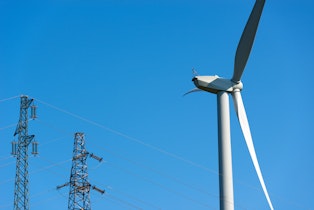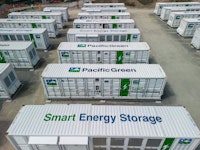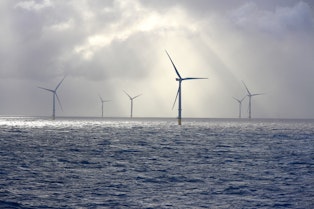The adage ‘waste not, want not’ might sound wise coming from your grandmother. But it is not so cute when, in terms of energy, it’s costing us billions of pounds. As consumers face mounting power bills, free energy is being thrown away simply because it cannot be stored for later.

This practice, called curtailment, has become an extremely serious issue—and one that will only escalate as the proportion of renewables on the grid increases. Curtailment refers to the deliberate reduction, or limitation, of electricity generation due to economic reasons and grid constraints.
The process is mostly associated with renewable energy, such as wind and solar, when there’s an excess of electricity and insufficient demand. If the grid can’t absorb it, energy is curtailed to prevent overloading. It sounds innocent enough, but curtailment is eye-wateringly costly.
And while it is a global issue, the UK is taking a big hit because of its high dependence on wind power and limited interconnection capacity with neighbouring countries.
If left unchecked, the problem could threaten our energy transition, because curtailment means lost revenues for project developers and therefore less of an incentive to build more projects.
“One of the major problems facing the wind and solar industries is that renewable energy is always the first to get axed when supply exceeds demand on the National Grid,” noted the industry information provider Tamarindo.
“This is despite the fact that electricity generated from wind/solar/hydro/marine sources contributed 31% of the UK’s electricity generation in 2022—by way of comparison, gas accounted for 38% and nuclear accounted for 15% (with coal and oil accounting for 2%).”
The good news is that the issue has a simple solution: build more energy storage. The business case in the UK is clear. Estimates show that curtailment has cost Britons £1 billion over the last three years alone.

Data reveals that the National Grid Electricity System Operator (ESO) paid £215 million to wind generators in 2022, in return for them curtailing the amount of power they were producing, and an estimated £717 million to purchase gas-powered electricity to cover the difference.
These costs are ultimately passed on to the consumer. While recovering from those shocking statistics, consider the numbers from 2020 to 2021, which show that wind farms across the UK received £806 million in curtailment payments. Scotland’s generators received 82% of that sum.
Breaking it down even further—and not to be a Grinch--the UK Wind Curtailment Monitor app shows that on Christmas Day 2022, the UK spent £9.2 million on curtailment. That was enough to power 11,000 homes. Not exactly what you want to find in your renewable energy stocking.
While we can all appreciate that the priority of the National Grid is to keep us safe, the price tag is untenable.
To make matters worse, it has been reported that fossil fuels have received £20 billion more in support from the UK government to deal with renewable intermittency in the last eight years.
Traditionally, because of the irregular nature of renewable generation, the National Grid favours fossil fuels and nuclear energy to balance the grid. As our reliance on renewables increases, these costs will only increase too.
The National Grid ESO has forecast that constraint costs may even rise to as much as £2.5 billion per year by 2025, before the necessary upgrades are made to the grid. Some warn this may sound a death knell for the renewable sector but really what’s required is more forensic planning.
Renewable UK’s director of future electricity systems, Barnaby Wharton, says: “We’ve known for years that more renewables need to be built to meet our goals, but the network has not kept pace.”
The upshot, he says, is that this is “creating bottlenecks and constraints in the system, and this is costing consumers hundreds of millions of pounds.”
Adding to the problem in future, Ofgem and the National Grid have laid out plans to overhaul underwater and onshore transmission networks and connect around 50 GW of offshore wind to the grid by 2030.
This includes two new undersea cables between Scotland and England which have already been approved. Lucy Yu, CEO of the Centre for Net Zero, says: “The UK is wasting a lot of wind power—and this is only set to continue.

“The grid’s capacity is holding back our ability to effectively harness the growing amount of green energy that’s available. Building more cables is important, but we can also use our existing infrastructure more intelligently.”
Losing enough clean wind energy to power a million homes a year is clearly unacceptable. Yet a rough calculation shows that the amount that could be lost through curtailment is more than the investment in battery storage that’s expected in the UK up to 2030.
This theoretically means that UK battery storage deployment could pay for itself in reduced curtailment costs.
According to Rystad Energy, the technology looks set to attract around £16 billion in investment, with the combined energy reserves of these battery storage systems potentially powering 18 million homes.
The battery storage market is already surging in the UK, with capacity set to hit 24 GW by the end of the decade. The UK now accounts for 9% of global installations, putting it at fourth place behind China, the US and Germany.
The bottom line is that further energy storage investment is needed and that’s good news for investors.
Last year, the Department for Business, Energy & Industrial Strategy awarded nearly £7 million to boost UK projects that are developing innovative energy storage technologies, in the first round of a government-backed competition.
More recently, UK Prime Minister Rishi Sunak eased a ban on new offshore wind farms in England in an effort to make it easier for them to be constructed. The new rules come into play next April but to really entice onshore wind developers it will be key to get curtailment under control.
Using battery storage, that control could be achieved without hitting the taxpayer where it hurts.
Publish date: 11 September, 2023